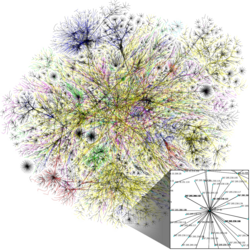Web
Web[edit]
The Web, also known as the World Wide Web (WWW), is an information system where documents and other web resources are identified by Uniform Resource Locators (URLs), which can be interlinked by hypertext, and are accessible over the Internet. The resources of the Web are transferred via the Hypertext Transfer Protocol (HTTP) and can be accessed by users through a web browser.
History[edit]
The Web was invented by Tim Berners-Lee in 1989 while working at CERN. Berners-Lee proposed a system to allow researchers to share information more easily. The first website was launched on August 6, 1991, and it provided information about the World Wide Web project.
Components[edit]
The main components of the Web include:
- Web browser: Software applications used to access and view websites. Examples include Google Chrome, Mozilla Firefox, and Microsoft Edge.
- Web server: Computers that store and deliver web pages to users. Popular web servers include Apache HTTP Server and Nginx.
- HTML (Hypertext Markup Language): The standard markup language used to create web pages.
- CSS (Cascading Style Sheets): A style sheet language used for describing the presentation of a document written in HTML.
- JavaScript: A programming language that enables interactive web pages.
Functionality[edit]
The Web operates on a client-server model. Users (clients) request web pages from servers using their web browsers. The server then sends the requested web page to the client, which is rendered by the browser. This process involves several steps: 1. The user enters a URL in the web browser. 2. The browser sends an HTTP request to the web server. 3. The server processes the request and sends back the requested web page. 4. The browser renders the web page for the user to view.
Web Technologies[edit]
Several technologies are used to enhance the functionality of the Web:
- AJAX: A technique for creating fast and dynamic web pages by exchanging small amounts of data with the server behind the scenes.
- WebSocket: A protocol providing full-duplex communication channels over a single TCP connection.
- REST (Representational State Transfer): An architectural style for designing networked applications.
Impact[edit]
The Web has had a profound impact on society, transforming how people communicate, access information, and conduct business. It has enabled the rise of e-commerce, social media, and online education.
Related Pages[edit]
| Internet |
|---|
|
|
Ad. Transform your life with W8MD's Budget GLP-1 injections from $75


W8MD offers a medical weight loss program to lose weight in Philadelphia. Our physician-supervised medical weight loss provides:
- Weight loss injections in NYC (generic and brand names):
- Zepbound / Mounjaro, Wegovy / Ozempic, Saxenda
- Most insurances accepted or discounted self-pay rates. We will obtain insurance prior authorizations if needed.
- Generic GLP1 weight loss injections from $75 for the starting dose.
- Also offer prescription weight loss medications including Phentermine, Qsymia, Diethylpropion, Contrave etc.
NYC weight loss doctor appointmentsNYC weight loss doctor appointments
Start your NYC weight loss journey today at our NYC medical weight loss and Philadelphia medical weight loss clinics.
- Call 718-946-5500 to lose weight in NYC or for medical weight loss in Philadelphia 215-676-2334.
- Tags:NYC medical weight loss, Philadelphia lose weight Zepbound NYC, Budget GLP1 weight loss injections, Wegovy Philadelphia, Wegovy NYC, Philadelphia medical weight loss, Brookly weight loss and Wegovy NYC
|
WikiMD's Wellness Encyclopedia |
| Let Food Be Thy Medicine Medicine Thy Food - Hippocrates |
Medical Disclaimer: WikiMD is not a substitute for professional medical advice. The information on WikiMD is provided as an information resource only, may be incorrect, outdated or misleading, and is not to be used or relied on for any diagnostic or treatment purposes. Please consult your health care provider before making any healthcare decisions or for guidance about a specific medical condition. WikiMD expressly disclaims responsibility, and shall have no liability, for any damages, loss, injury, or liability whatsoever suffered as a result of your reliance on the information contained in this site. By visiting this site you agree to the foregoing terms and conditions, which may from time to time be changed or supplemented by WikiMD. If you do not agree to the foregoing terms and conditions, you should not enter or use this site. See full disclaimer.
Credits:Most images are courtesy of Wikimedia commons, and templates, categories Wikipedia, licensed under CC BY SA or similar.
Translate this page: - East Asian
中文,
日本,
한국어,
South Asian
हिन्दी,
தமிழ்,
తెలుగు,
Urdu,
ಕನ್ನಡ,
Southeast Asian
Indonesian,
Vietnamese,
Thai,
မြန်မာဘာသာ,
বাংলা
European
español,
Deutsch,
français,
Greek,
português do Brasil,
polski,
română,
русский,
Nederlands,
norsk,
svenska,
suomi,
Italian
Middle Eastern & African
عربى,
Turkish,
Persian,
Hebrew,
Afrikaans,
isiZulu,
Kiswahili,
Other
Bulgarian,
Hungarian,
Czech,
Swedish,
മലയാളം,
मराठी,
ਪੰਜਾਬੀ,
ગુજરાતી,
Portuguese,
Ukrainian

